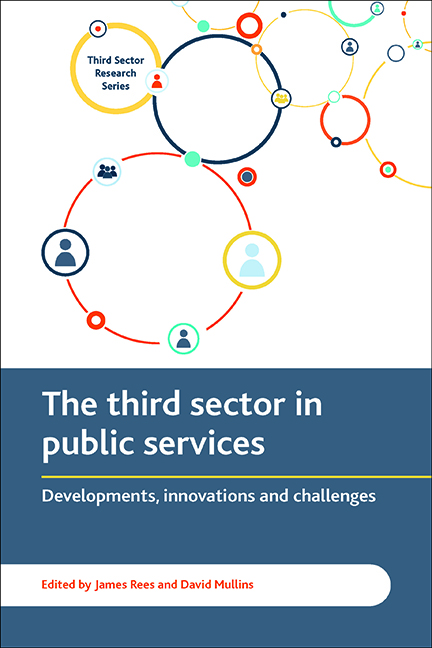Book contents
- Frontmatter
- Contents
- List of tables, figures and boxes
- Series editor’s foreword
- Notes on contributors
- one The third sector delivering public services: setting out the terrain
- Part One Policy, politics and organisations
- Part Two Cross-cutting issue for third sector service delivery
- Part Three Service delivery in key policy fields
- Index
four - Which third sector organisations are involved in the delivery of public services? Evidence from charity accounts and from survey data
Published online by Cambridge University Press: 05 April 2022
- Frontmatter
- Contents
- List of tables, figures and boxes
- Series editor’s foreword
- Notes on contributors
- one The third sector delivering public services: setting out the terrain
- Part One Policy, politics and organisations
- Part Two Cross-cutting issue for third sector service delivery
- Part Three Service delivery in key policy fields
- Index
Summary
Introduction
The delivery of public services is an important part of the activities of the third sector but it is difficult to gain a granular picture of which organisations are engaged in it and where they are located. Discussion has tended to focus instead on the level of public funding going to the sector, and to its growth and distribution. It might seem reasonable to assume that those funds are provided so that third sector organisations can deliver services commissioned on behalf of government (central or local), but we show that by no means all those third sector organisations in receipt of public money consider that they are delivering public services. Nor do they necessarily feel that those services are what constitutes the most important elements of their activity.
There is, in fact, a long history of payments from statutory authorities to voluntary organisations. Some 80 years ago Braithwaite (1938) demonstrated the significance of public payments to British voluntary organisations, anticipating comments about the ‘shadow state’ (Wolch, 1990) by half a century. And in the US, state payments to charities date back over a century (Salamon, 1987). In the UK, Unell (1979) estimated that fees and charges accounted for nearly 40% of total incoming resources of her sample of (mainly social service) charities. Interestingly, despite subsequent debate about the negative implications of a shift from grants to contracts, only 4% of the income of her sample was provided by grants. Thus, for these organisations, contractual arrangements already seemed to be the norm. The National Council for Voluntary Organisations (NCVO) (2000), reviewing the 1991 to 1997 period, showed that public grants and fees accounted for between 18–20% of income, although this was for a much broader population of charities. Since 1997, receipts from the public purse have been increasing steadily. NCVO's widely used series of annual estimates of charity incomes shows that the sector receives substantial public funding from statutory sources, accounting, on some estimates, for over 35% of total incoming resources to the third sector (Clark et al, 2013).
These trends have been criticised from both the left and right. For over 30 years, governments have advocated the value of third sector involvement in achieving a growing range of policy goals, but under the Labour government, the third sector was ‘mainstreamed’ into a large range of policy fields (Kendall, 2000).
- Type
- Chapter
- Information
- The Third Sector Delivering Public ServicesDevelopments, Innovations and Challenges, pp. 63 - 84Publisher: Bristol University PressPrint publication year: 2016



